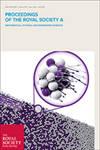有磁场存在的成分对流。一、单一接口
Proceedings of the Royal Society of London. Series A. Mathematical and Physical Sciences
Pub Date : 2004-12-08
DOI:10.1098/rspa.2004.1375
引用次数: 16
摘要
我们研究了两种不同轻物质组成的半无限流体在磁场作用下的垂直界面的稳定性。两种流体都具有有限的运动粘度、ν、热扩散系数、κ、磁扩散系数、η和可忽略的物质扩散。稳定性取决于6个无量纲参数:普朗特数σ(其中σ = ν/ κ)、磁普朗特数σm = ν/η、钱德拉塞卡数Qc、雷诺数Re以及垂直分量和法向分量与场横向分量之比Bv Γ。在Re较小时,全面研究了稳定性对参数的依赖关系。水平磁场的存在往往会降低非磁性模态的增长率,也会产生新的不稳定模态。增加垂直分量的场可以完全抵消水平分量的稳定作用。当磁场强度超过与σ、σm和Bv有关的某一值时,非磁性不稳定模式被两种磁性模式中的一种所取代,其中一种是与磁场成直线的辊,另一种是与磁场倾斜的辊。讨论了小尺度不稳定运动的螺旋度和α -效应。本文章由计算机程序翻译,如有差异,请以英文原文为准。
Compositional convection in the presence of a magnetic field. I. A single interface
We investigate the stability of a vertical interface separating two semi–infinite fluids with differing composition of light material and permeated by a magnetic field. Both fluids possess finite kinematic viscosity, ν, thermal diffusivity, κ, magnetic diffusivity, η, and negligible material diffusion. The stability depends on six dimensionless parameters: the Prandtl number, σ (where σ = ν/ κ), the magnetic Prandtl number, σm = ν/η, the Chandrasekhar number, Qc, the Reynolds number, Re, and the ratios, Bv, Γ of the vertical and normal components to the lateral component of field. A comprehensive study of the dependence of the stability on the parameters is made when Re is small. The presence of a horizontal magnetic field tends to reduce the growth rate of the non–magnetic modes and can also give rise to new modes of instability. The addition of a vertical component of field can completely counteract the stabilizing influence of the horizontal component. For field strengths in excess of some value dependent on σ, σm and Bv, the non–magnetic unstable mode is replaced by one of two magnetic modes, one of which is a roll aligned with the field and the other inclined to it. The helicity and α–effect of the small–scale unstable motions are also discussed.
求助全文
通过发布文献求助,成功后即可免费获取论文全文。
去求助
来源期刊
自引率
0.00%
发文量
0
期刊介绍:
Proceedings A publishes articles across the chemical, computational, Earth, engineering, mathematical, and physical sciences. The articles published are high-quality, original, fundamental articles of interest to a wide range of scientists, and often have long citation half-lives. As well as established disciplines, we encourage emerging and interdisciplinary areas.

 求助内容:
求助内容: 应助结果提醒方式:
应助结果提醒方式:


